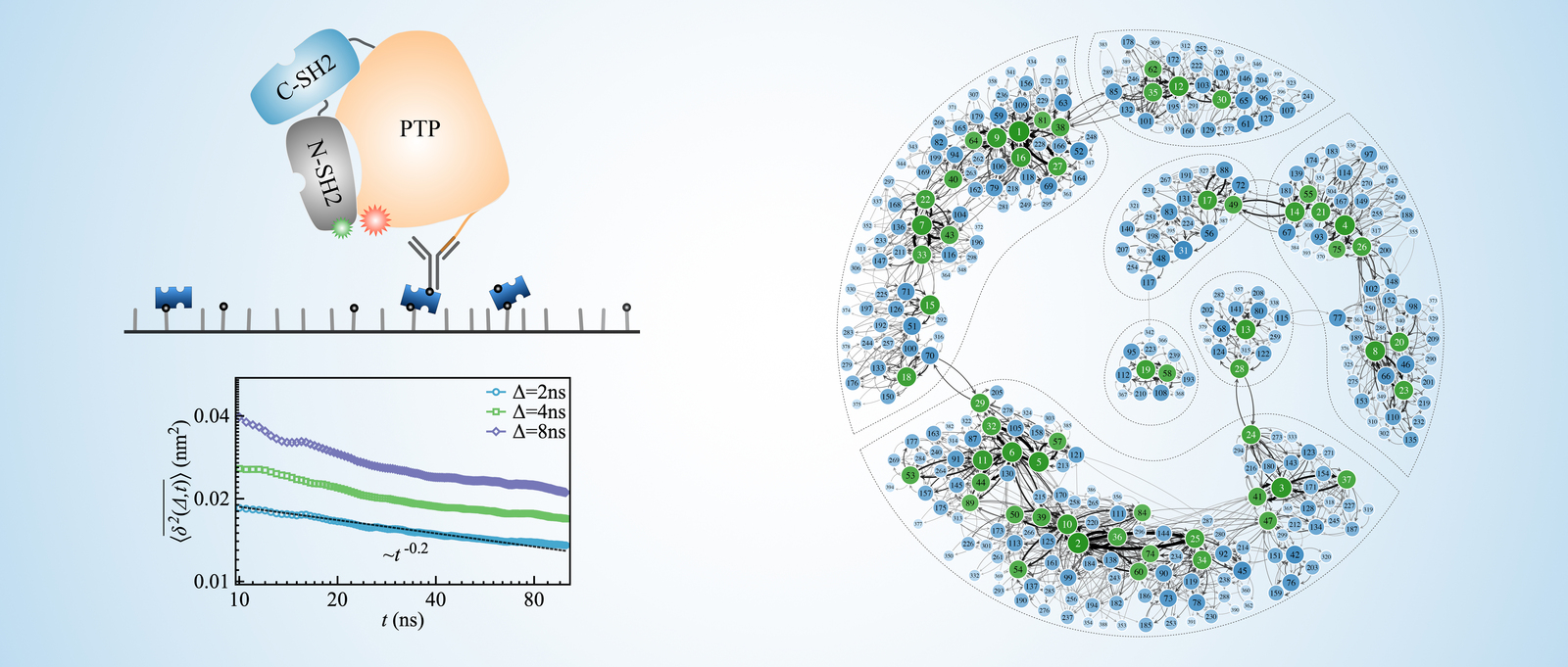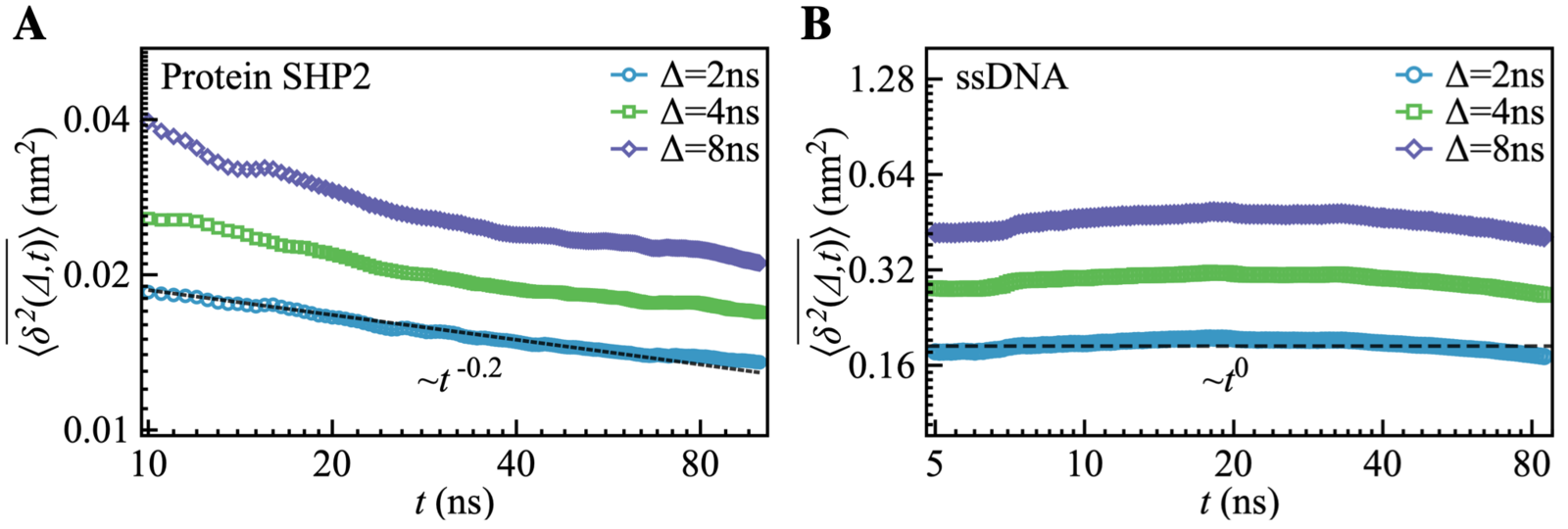← Back
上海交大洪亮课题组揭示蛋白质动力学随着观测时间增长而逐渐变慢的奇异现象
2022年8月
近日,上海交通大学自然科学研究院和物理与天文学院洪亮教授课题组和合作者在英国皇家化学学会(Royal Society of Chemistry)的旗舰期刊《Chemical Science》上发表了题为“Non-ergodicity of a globular protein extending beyond its functional timescale”的最新研究成果,报道了蛋白质功能运动随着观测时间增长而逐渐变慢的奇异现象,并解释了其微观机理。

蛋白质分子的内部运动,尤其是功能结构域间的相对运动与其完成各种生物功能或者催化作用紧密相关。然而有趣的问题是:一种特定的功能运动是否有特定的时间尺度与其对应呢?在序列,结构和环境完全一样的情况下,同一种蛋白分子的动力学或者功能是否会存在个体差异呢?洪亮课题组通过全原子分子动力学模拟和单分子能量共振荧光显微镜实验,对SHP2络氨酸磷酸酶蛋白单分子的动力学行为进行了统计研究。结果表明,在结构和环境完全一样的情况下,横跨14个时间尺度(从皮秒到分钟:10^-12 - 10^2秒),每个蛋白质分子动力学行为各不相同,有快有慢,有动有静,而且整体随着观测时间变长逐渐减慢(图1A)。然而这些新奇现象却与单链DNA的运动行为形成鲜明对比,后者个体差异基本没有(图1B)。团队借助复杂网络和图论的知识,刻画出蛋白质和DNA分子的自由能势能面,并对比分析,发现蛋白分子的新奇运动是由其自相似、分形的“链-岛”自由能图谱造成的(图2)。本工作的一个重要衍生结果是,一模一样的蛋白质分子,其功能效率和动力学行为个体差异很大,对自然环境的适应能力可以非常不同,出现种群分化“population splitting”。这将有助于生物大分子乃至生命体在恶劣环境下演化,部分种群得以生存。

图1: 蛋白质的老化“aging”动力学。(A). 蛋白质分子的运动随着观测时间变长而逐渐减慢。(B). 单链DNA分子并无老化动力学行为。

图2: 分子的构象转移网络,边或点的颜色深浅与概率成正比,因此它代表蛋白分子的能量势能面。(A). 蛋白分子“链-岛”状势能面。(B). 单链DNA分子的运动网络。
上海交通大学自然科学研究院和物理与天文学院洪亮教授为本文唯一通讯作者,物理与天文学院博士生李俊为第一作者。理论模型的改进得到了美国田纳西大学/橡树林国家实验室Prof. Jeremy C. Smith,和德国马克斯·普朗克研究所Dr. Aljaž Godec的帮助。单分子实验设计和数据采集得到了中国科学院上海有机化学研究所刘聪研究员和谢静菲博士的帮助,单分子实验同样也得到了美国北卡罗来州立大学Prof. Keith R. Weninger的帮助。本工作得到了国家自然科学基金委、上海市科委、教委、上海人工智能国家实验室和张江高等研究院的支持,以及上海交通大学学生创新中心和上海交通大学高性能计算中心的支持。
Recently, Chemical Science, the flagship journal of the Royal Society of Chemistry, published a new edge research article entitled as “Non-ergodicity of a globular protein extending beyond its functional timescale” by Prof. Liang Hong’s group (Institute of Natural Sciences & School of physics and astronomy & Zhangjiang Institute for Advanced Study), which reported the non-ergodic protein internal dynamics that the functional dynamics in a multi-domain protein slows down with increasing the observational time and it exhibits a large degree of heterogeneity among individual protein molecules.
Protein internal dynamics is crucial for its function. How these motions on different timescales relate to and influence each other, and how the overall characteristics of internal dynamics relate to biological function is of particular interest in biophysics. Also, the intriguing possibility exists that otherwise identical single protein molecules might be physically distinct on timescales approaching their functional times (e.g., enzyme catalytic rates). In this regard, a particularly interesting question is whether internal protein dynamics is ergodic, i.e., time-averaged observables are equal to its ensemble average.
The group performed numerous single-molecule fluorescence resonance energy transfer (smFRET) experiments and molecular dynamics (MD) simulations to study the internal dynamics of a multi-domain protein, SHP2. The results demonstrate that functional inter-domain motions in the protein show heterogeneity and non-ergodicity over wide time windows: from 10^-12 to 10^2 s. Moreover, we observed striking aging behavior, i.e., the effective internal flexibility of the protein decrease with observation time. Furthermore, as illustrated by control simulations and experiments on a single-strand DNA (ssDNA)of similar size, which behaves ergodically with an energy landscape resembling a one-dimensional linear chain. We demonstrate that the anomalous dynamics of the protein arise from the characteristic protein energy landscape, which has a much higher dimensionality that that of the ssDNA, unique hierarchical structure, and “chained-islands” topology. The present findings significantly recast existing ideas in molecular biophysics connecting ensemble-averaged protein dynamics to biological function. Instead, non-ergodicity splits the population of otherwise identical proteins into subpopulations with drastically distinct conformations, flexibilities, and reaction rates over timescales longer than needed for the biological function.
The first author of this article is Ph.D. student Jun Li from Prof. Liang Hong’s group, and Prof. Liang Hong from the Institute of Natural Sciences and School of Physics and Astronomy is the corresponding author. The theoretical model was developed with the help of Prof. Jeremy C. Smith from the University of Tennessee and Oak Ridge National Laboratory (USA), and Dr. Aljaž Godec from Max Planck Institute for Biophysical Chemistry (Germany). The single-molecule experiments were carried out with the help of Dr. JingFei Xie, Associate Prof. Cong Liu in the Chinese Academy of Sciences (China), and Prof. Keith R. Weninger from North Carolina State University (USA). The work was supported by the National Natural Science Foundation of China, Student Innovation Center, and Center for High-Performance Computing at SJTU.

